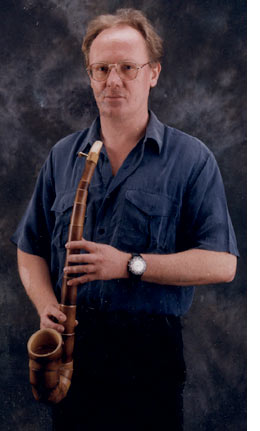 The Xaphoon (also known as Maui Xaphoon or Bamboo Sax) is a single-reed keyless bamboo wind instrument. The Xaphoon was invented during the 1970s by the American instrument maker Brian Wittman, who still makes all of his instruments by hand, using local bamboo cut from the forests of the eastern end of his home island of Maui, Hawaii. It is very similar in construction to the chalumeau, a keyless European single reed folk instrument that was the ancestor of the clarinet. Although the Xaphoon is referred to as a Bamboo Saxophone, it is actually more similar in tone to a clarinet in its lower octave. Its sound also bears some resemblance to cylindrical double reed instruments with a similar timbre such as the Armenian duduk or the Chinese guan.
The Xaphoon (also known as Maui Xaphoon or Bamboo Sax) is a single-reed keyless bamboo wind instrument. The Xaphoon was invented during the 1970s by the American instrument maker Brian Wittman, who still makes all of his instruments by hand, using local bamboo cut from the forests of the eastern end of his home island of Maui, Hawaii. It is very similar in construction to the chalumeau, a keyless European single reed folk instrument that was the ancestor of the clarinet. Although the Xaphoon is referred to as a Bamboo Saxophone, it is actually more similar in tone to a clarinet in its lower octave. Its sound also bears some resemblance to cylindrical double reed instruments with a similar timbre such as the Armenian duduk or the Chinese guan.The Xaphoon, which is available in the keys of C, B♭, and D (as well as any other key via special order) uses a regular tenor saxophone reed. Its body is 12.5 inches in length (for the instrument pitched in C) and has nine holes (eight holes in front and one thumb hole in back, for the left hand) that resemble those of a recorder. The Xaphoon's fingerings, however, are significantly different from those of either a saxophone or recorder. It has a range of two octaves and is fully chromatic. On the instrument's website, Wittman explains the origin of the instrument's unusual name: “A name developed from ‘bamboozaphone’ to ‘bamboozafoon’ to ‘bamboo zafoon’ to just ‘zafoon’, also spelled ‘Xaphoon’.”
In 2000, the instrument was made available also in a plastic version, which is marketed under the name Pocket Sax. Currently, its plastic (mass produced version) is only available in the key of C, with its lowest tone being middle C. Its versatility, tone, low price, and portability made it a suitable alternative to the harmonica or tin whistle for travelers who wish to bring an instrument with them in their pocket.
The first Xaphoon orchestra originated in Norway in 2006, under the name Trondheim Xaphoon og Vorspielensemble (Trondheim Xaphoon and Vorspiel Ensemble). They had their highly successful debut under the national wind band championships in Trondheim on March 31.
Tekið af Wikipedia
